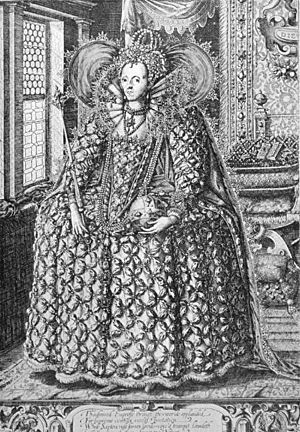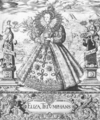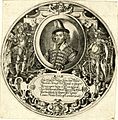William Rogers (engraver) facts for kids
William Rogers was an English artist who lived around the late 1500s. He was a very important engraver, which means he made pictures by carving designs into metal plates, then using those plates to print images onto paper. He was also a goldsmith, someone who works with gold, and he probably learned his engraving skills from that job.
Rogers was the first English artist known to be a professional engraver, and he became the best portrait engraver during the time of the Tudor period in England. Even though other countries in Europe had been making prints for a long time, England was quite late to start.
Contents
Famous Engravings of Queen Elizabeth I
William Rogers is especially known for his detailed portraits of Queen Elizabeth I. These prints are quite rare today.
Eliza Triumphans
One of his famous works is called Eliza Triumphans (meaning "Elizabeth Triumphs"), made in 1589. This engraving celebrates England's victory over the Spanish Armada in 1588. It shows Queen Elizabeth surrounded by special symbols that represent her power and the English empire.
Queen Elizabeth Standing in a Room with a Lattice Window
Another well-known engraving is Queen Elizabeth Standing in a Room with a Lattice Window. This picture was based on a drawing of the Queen by a miniature painter named Isaac Oliver. Rogers likely added the very detailed and decorated background himself.
Elizabeth I as Rosa Electa
Rogers also created Elizabeth I as Rosa Electa (meaning "Elizabeth I as the Chosen Rose"). This engraving doesn't have a date, but experts believe it was made later in Elizabeth's reign because of the style of her clothing. In this portrait, the Queen is surrounded by roses. These roses were a symbol of the Tudor family, showing how they united the York and Lancaster families.
The Family of Henry VIII
Rogers also made an engraved version of a large painting called The Family of Henry VIII, which is now at Sudeley Castle. His print shows Queen Elizabeth wearing the latest fashions from the 1590s. It also includes verses at the bottom that highlight the difference between her sister Mary I's marriage, which led to war, and Elizabeth's choice to remain unmarried, which brought peace and plenty to England.
Other Works by William Rogers
Besides his famous portraits of Queen Elizabeth, William Rogers engraved many other pictures. He created portraits of important people, designed title pages for books, and made illustrations inside books.
For example, he engraved the title pages for:
- Jan Huyghen van Linschoten's Discours of Voyages into ye Easte and West Indies (1596), which was about travels to far-off lands.
- Sir John Harington's translation of Ariosto's Orlando Furioso (1591), a famous poem.
He also created the portrait of the author and the title page for John Gerard's The Herball, or a Generall Historie of Plantes (1597), a very important book about plants. Rogers's work can also be found in other books like Broughton's Concert of Scripture (1596), William Segar's Honor, Military and Civile (1602), and Milles's Catalogue of Honour, or Treasury of True Nobility (1610).
William Rogers was recognized as a skilled artist during his time. He was even mentioned by a writer named Francis Meres in his book Palladis Tamia (1598), where he was listed among other excellent engravers.
Images for kids
-
Eliza Triumphans (1589), British Library
-
Elizabeth I as Rosa Electa, Bodleian Library
-
The discription of the Islandes and Castle of Mozambique (1598), British Museum
-
Robert Devereux, 2nd Earl of Essex (1598–1600), British Museum
-
George Clifford, 3rd Earl of Cumberland (1595–1600), British Museum
-
Thomas Docwra, Grand Prior of the English Knights Hospitallers, (1595-1602)
-
Charles Howard, 1st Earl of Nottingham, (1595-1602)
-
Emmanuel Philibert, Duke of Savoy, (1595-1602)
-
Henricus Borbonius 4 Rex Franciæ et Navarræ Ordin. S. Spiritus Eques Supremus (1602), British Museum
-
The coats of arms of sixty-eight kingdoms, cities and towns around the world (after 1603), British Museum














